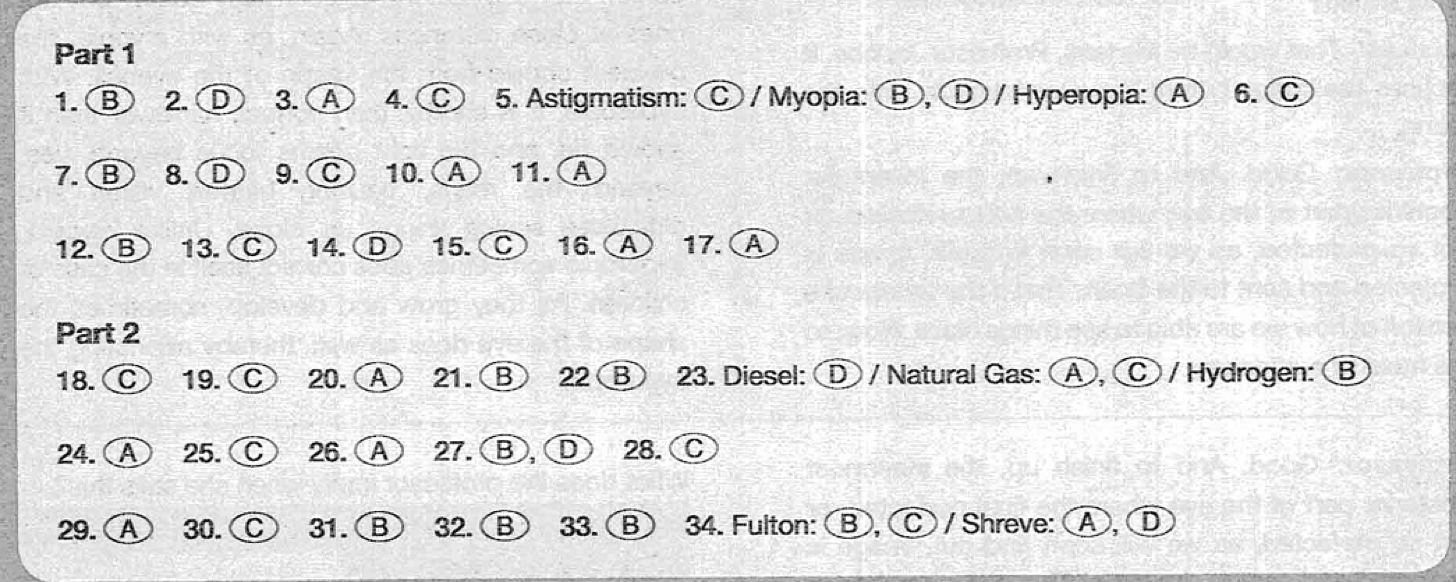TOEFL IBT Listening Practice Test 15 from TOEFL iBT Actual Test Solution KEY

TOEFL IBT Listening Practice Test 15 from TOEFL iBT Actual Test Transcripts

LECTURE 1 -6
Listen to part of a lecture in an anatomy class.
Professor: When it comes to our vision, of course, all of the components of the eye are important. By the same token, some are a little bit more important than others. Also, if one of these parts becomes injured through trauma or doesn’t develop correctly, problems with our vision will occur. Is everyone with me? Excellent. Can everyone see me okay? Sony, sorry, poor joke. I know. Back to the eye. Can everyone please take a look at the diagram in their books on page, uh, let’s see, 898? Everyone there? Okay. Now, as we look at this bisection of the human eye, I want you to, um, focus on, sorry, class, the five parts, called the cornea, the iris and pupil, the lens, and, lastly, the retina. Now, I know most of you know what the basic functions of these are, but I want to go over them briefly just to refresh everyone’s mind. It will help us understand in a minute the main point of our discussion today: common eye problems and their causes. Let’s work from left to right with the diagram, that is, from the external to the internal area. The first component we come across is the cornea. Who can explain its function in basic terms? Yes, over here in the front.
Student: Professor Jacobs, the cornea is the transparent, protective shell that covers the pupil and iris.
Professor: That’s right. It protects the internal workings of the eye from things like foreign debris. Which brings us to the iris and the pupil, which work together in a way. The iris is the colored part of the eye that’s made up of tiny muscles that control the opening and closing of the pupil, which is basically the aperture of the eye, similar to that of a camera. The pupil regulates the amount of light allowed into the eye. You guys still able to follow everything okay…? Good. What’s next?
Student: That would be the lens, Professor Jacobs. It focuses the image before it moves inwardly onto the retina.
Professor: Good. And to finish up, the innermost posterior part of the eye where the final perfected, or not so perfected, as we will soon find out, image is projected and sent to the brain. That’s the barebones version of how we are able to see things class. Now, to the meat of our lecture.
There are numerous problems that can occur when it comes to vision, and many of them are hereditary. The first one I’d like to discuss with you guys today is called astigmatism. Astigmatism is the most common of all other vision problems, and it stems from the cornea. When the cornea is not shaped correctly, that is, instead of being oval, it is shaped more like an egg, astigmatism is the result. Let me explain. As light enters the eye, it bends differently because of the egg-like shape of the cornea. Once this occurs, the lens has difficulty focusing on one single point because light rays are bending and creating different focal points. Because of these multi-focus points, the image becomes blurred or out of focus when it hits the retina. Is this clear to everyone? I did it again, didn’t I! Well, I’ll take your laughter as a yes then, class. Good. Symptoms of astigmatism are, of course, blurred vision and, in more extreme cases, headaches. Are there any questions at this point, class? No. Very well.
The second vision problem I’d like to discuss is myopia. It’s sometimes called near-sightedness, but don’t let the name fool you. People with myopia have difficulty seeing objects far away but can see things up close very easily, such as a book or magazine or perhaps a computer screen. The cause of myopia is again a physiological one as it is with astigmatism. The actual eyeball is oblong, elongated length-wise from the front to the rear. This causes the light to focus prematurely before it has a chance to reach the retina. Also, myopia can be a degenerative condition with age. This condition is called myopic creep.
Okay, if there aren’t any questions or comments, I’ll start in on the third common vision problem. This is called hyperopia, or far-sightedness, the exact opposite, as you can imagine, of myopia In this case, a person can see distant objects fairly easily, but not ones at close distances. Again, as with myopia, the problem comes from the shape of the eyeball. With hyperopia, it is shorter than normal, narrower than it should be, and the light beams focus beyond, yes, beyond, the retina, causing blurred vision and difficulties seeing things up close. Unlike myopia, hyperopia sometimes does correct itself in the case of children. As they grow and develop, sometimes the shape of the eye does as well, thereby alleviating the hyperopia.
————————————0O0——————————————
CONVERSATION 7-11
Listen to part of a conversation between a student and a professor.
Student: Professor Martin, could I have a word with you for a moment, please?
Professor. Of course. It’s Janet, isn’t it?
Student: Wow, I can’t believe you actually know my name. Our class is pretty big.
Professor; Well, I pride myself on being able to remember who each of my students is. I feel that doing so makes me, well, a better teacher. And I bet you’re here because of your recent midterm grade, aren’t you?
Student: Uh, yes, sir, I am. It’s just that, well, you know, I’ve never actually gotten a C on an exam before, so I was kind of, ah, wondering what exactly I did wrong on the test. Do you think you could give me a couple of pointers or something?
Professor. Well, if I recall correctly, you’re a freshman, right? And I’m willing to bet that this is one of the first tests that you’ve ever taken in college. Am I correct about this?
Student: Yes, sir. Well, I did attend a summer program at a college between my junior and senior years in high school, but, yes, this is actually the second… no, the third test that I’ve taken in my college career.
Professor: All right. Well, let me explain a few things to you. First, remember that college is a lot different than high school. My history class is probably much different from the history classes you took in high school. In my class, I don’t want you just to regurgitate names, dates, and places. Instead, I want you to interpret these events for me. Tell me not only what happened but why it happened. That might take a little getting used to, but it’s something that you’ll have to do if you want to pull out a decent grade in my course.
Student: Yes, sir. I think that I understand. Do you have any other tips for me?
Professor: Well, I think that it might be a good idea if you were to go speak with one of the department’s teaching assistants. I actually have one in our class. His name is Tom, Tom Watkins. His job is to help students like you. He’s really good and wants to become a teacher himself, so he should be able to, shall we say, lead you by the hand to get to where you want to be in this class.
Student: Well, that sounds very helpful. Where can I find Tom’s office?
Professor Well, TAs don’t have offices of their own, but if you go to the graduate student lounge on the third floor, you should be able to ask around and find him. He’s typically at school all day long.
Student: Great. I think that I’ll do that.
Professor: Do you have anything else to talk about?
Student: Well, I know that I didn’t get the best grade on the midterm, but, uh, is there a way that I can pull out an A in the class?
Professor: Hmm… I tell you what. You work hard with Tom, write an excellent report for me on our next assignment, and then ace the final, and I don’t see why I shouldn’t be able to reward you with a stellar grade.

